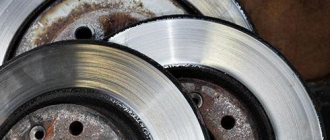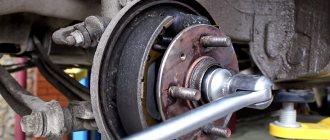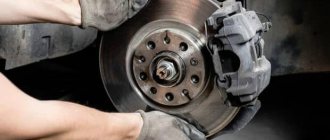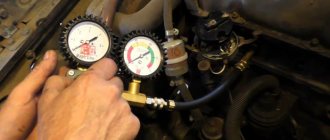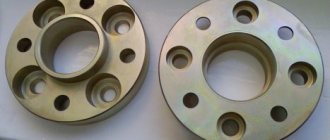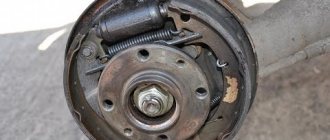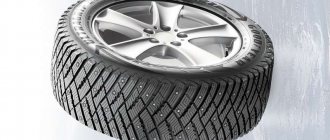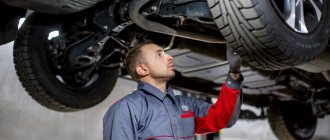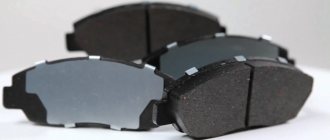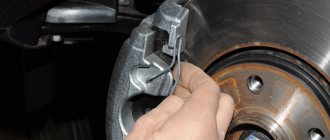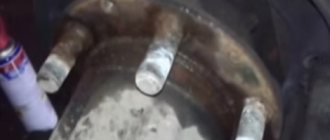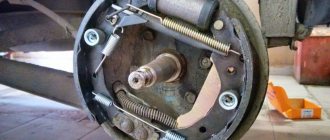While some drivers almost never use some car functions (the parking lights in BMW (Parking Lamps) are a prime example), the brakes are used constantly on any car. At the same time, they are sometimes deprived of attention.
Yes, yes, almost every motorist knows that the pads need to be changed periodically and the brake fluid level must be checked occasionally. How often should brake discs be changed?
In fact, few will give a concrete answer to this question. Wear greatly depends on operating conditions. Car manuals may not indicate the frequency of replacement at all, but at the same time instruct technicians to check their condition during each maintenance. With gentle use, the discs can travel more than 120 thousand kilometers, and in inept... legs they will require attention after 30 thousand.
Support discs, like pads, are consumables. The front ones especially, because they bear the lion's share of the load when slowing down and stopping the car.
Important: how quickly a brake disc wears down is influenced not only by operating conditions, but also by the choice of pads. The composition of the friction lining, which is in contact with the surface of the disc, varies. You may come across an aggressive version that literally eats metal and at the same time does not stand out in any way by improving tenacity.
Symptoms of wear parts
While driving, there are several signs that you can use to determine when it’s time to change the pads of the front or rear brakes, or even all together. The symptoms are:
- a metallic grinding sound when you press the pedal indicates complete wear of the linings;
- increased travel of the brake pedal, its vibration when pressed;
- when braking, there is a feeling that the front or rear of the car is being pulled to the side, and on a slippery road the car easily goes into a skid;
- the handbrake does not work properly;
- To stop you need to put more force on the pedal.
If, when braking, a metallic grinding and squeaking sound is heard from the wheels, then the question of how long to change the unusable parts is no longer worth asking. Replacement must be done urgently, since there are no friction linings left and the steel base is rubbing against the working surface of the disk.
Never allow the brakes to wear out completely, otherwise you will have to replace the discs along with the pads, which is significantly more expensive. If you notice one or more symptoms indicating problems with the wheel brake mechanisms, check the condition of the linings. Recommendations for performing diagnostics are as follows:
- If your car is equipped with alloy wheels with large holes, then you won’t have to disassemble anything to inspect the front calipers. If necessary, jack up the car to align the disc opening against the brake mechanism.
- Wheels with steel rims must be removed. Inspect the front brake pads and evaluate the thickness of the linings. If it is less than 3 mm, the parts should be replaced immediately. With a thickness of 3-5 mm you can drive another 1-2 thousand km, no more.
- Rear brakes are disc or drum. The first ones are examined similarly to the front ones, but the second ones will have to be disassembled. Remove the wheel and release the handbrake, then unscrew the drum and carefully knock it off the hub. Unlike the front pads, the rear pads need to be changed when the thickness is 1.5-2 mm.
When, as a result of diagnostics, wear of elements close to the maximum is detected, but replacement is postponed for various reasons, drive carefully and without haste. It happens that a worn lining comes off completely when you press the pedal sharply .
When conducting diagnostics, pay attention to the working surface of the brake drums and discs. If its wear is 2 mm or more (determined by the depth of the groove with a caliper), then the part must be replaced.
Important information about brake disc thickness
In the past, most brake rotors were designed to be thick enough that there was little need for replacement. Nowadays, in order to reduce weight and save some costs, many automakers often produce wheels with a thinner thickness. Thus, the rotors easily wear down to the minimum thickness (the appropriate tolerances are usually specified in the factory instruction manual or on the rotor casting), sometimes even by the time the first set of brake pads are replaced.
Example: The minimum thickness of a JCW rear brake disc is 8.4 mm. Knowing the minimum thickness of your car's disc is very important, because if the thickness of the car's rotor is less than the minimum level, your safety will be compromised. A worn or thinner rotor has less mass than a normal rotor, which reduces its ability to absorb and dissipate heat. In addition, the strength of the rotor is also reduced, leading to a greater risk of cracking and braking. For this reason, it is very important to check the rotor thickness every time you service your brake pads. If the rotor thickness is below the minimum specification or cannot be repaired, you must replace it immediately.
Cracked brake disc The front discs on your car are subject to more wear than the rear discs. But at the same time, both front discs usually wear out equally (as do the rear ones). Therefore, when it comes to replacing one worn rotor, this means that you must replace both rotors on the vehicle.
Auto experts advise replacing both rotors (even if one is still functional) at the same time to maintain even braking. A noticeable difference in rotor thickness can cause the brakes to be biased to one side.
Why is it so important to monitor the condition of your brake discs?
Discs and pads are subject to high loads while driving. Like any other car part, they tend to wear out. This in turn can affect the overall safety and reliability of the vehicle. Consequently, every car enthusiast must calculate the most important parameter so that nothing serious happens on the road.
Brake disc covered with erosion
What factors influence wear?
The wear of brake system components depends on many factors:
- poor quality material used by the manufacturer;
- installation of any element: pad, disc or drum was previously carried out incorrectly;
- aggressive driving style of the car owner.
We recommend: Types of brake fluid The reasons listed apply to all parts of the brake system. We’ll tell you how you can avoid such factors and significantly increase their service life.
Important! It is necessary to purchase parts from trusted manufacturers. There are plenty of counterfeit goods on the market.
The cheap cost of the product should indicate to the car enthusiast that the spare part can be made from low-grade raw materials. In this case, you won’t be able to save money: its service life may quickly end.
Important! Replacement of all brake elements must be carried out by qualified specialists at a service station. Their experience and modern repair equipment are the guarantee of installation. Repairs in a nearby garage or in “left” services are dangerous due to incorrect installation and repair costs, the purchase of new spare parts, and the creation of an emergency situation.
Important! Driving should be calm, without alternating sharp accelerations, sports starts at traffic lights and extreme braking. The listed actions lead to an increase in the temperature regime for parts and the creation of prohibitive loads. The result is their wear and failure.
What should be the thickness of brake pads?
A clear sign indicating that the pads are running out of service life is the appearance of a characteristic whistle when the car is braking - every time you press the pedal you will hear an unpleasant noise, similar to glass rubbing against metal.
If such a symptom appears, it is recommended to diagnose the brake system as soon as possible - remember, operating a car with faulty brakes negatively affects the safety of the driver and passengers.
| Characteristic | Wheel Bridge | Minimum thickness, mm |
| Disc diameter, mm | Front | |
| Rear | ||
| Structure thickness, mm | Front | |
| Rear | ||
| Possible runout, mm | Front | |
| Rear | ||
| Thickness of the brake lining together with the pad body, mm | Front | |
| Rear | ||
| Minimum permissible thickness of the lining together with the block body, mm | Front | |
| Rear | ||
| Minimum permissible disk thickness, mm | Front | |
| Rear |
It is also important to remember that these indicators may differ if the car has a power unit with a capacity of more than 125 horsepower or a total volume of working chambers of 2.0 liters or more. In this case, it is necessary to check the thickness level of the system components after first reading the data from the vehicle’s service book.
Note! On average, front and rear brake pads, regardless of the design of the system, wear out at different rates. This is explained by the difference in the applied dynamic force on the braking system - the front axle of the car experiences more pressure during a forced reduction in speed.
Design features
The bulk of the front and rear discs are made of cast iron. Its popularity was facilitated by its low cost and good friction properties. But the trouble is that during the braking process this material heats up. This can lead to warping, changing the shape of the working surface and ultimately uneven erasing. To minimize these phenomena, manufacturers began producing front and rear discs with internal ventilation. They also began to cut grooves on their surface and perforate this product. This made it possible to significantly reduce overheating and increase their operating time.
Effective adhesion between the pads and the disc begins only after they are ground in. At this time, you should not press the brake sharply, but stop smoothly. This usually happens with a mileage of no more than 1000 km. You can check the effectiveness of lapping on a special stand.
Limit value of residual thickness
Obviously, the intensity and duration of the impact of the listed circumstances on the service life of the braking system differs for each specific car - one driver drives carefully, another constantly loads the car, a third uses only high-quality original spare parts. We recommend:
Everything about motor oils for cars From a technical point of view, it is wrong to say that the time has come to replace the brake pads if a certain period of time has passed (for example, 1 year) or a certain mileage has been reached. The mileage resource, expressed in km, is an average value and can be used for guidance only. The following values are usually given: for disc brakes installed on both front and rear axles, it is 10–20 thousand km; for drum wheels, used mainly on the rear wheels – 100–150 thousand km.
In reality, the need for replacement occurs only when the maximum remaining thickness of the lining is reached. The manufacturer usually indicates this value on the product packaging, and the manufacturer - in the maintenance and repair manual. For most modern passenger cars, it fluctuates in the range of 1–2 mm for the brake mechanisms of both front and rear wheels.
Wear limit
Each brake disc has its own limited resource.
It is set by the manufacturer from the factory, and resource wear is affected by mileage, braking intensity, the condition of the entire braking system, the characteristic features of the vehicle itself, etc. When buying a new set of brake discs for his car, the driver must necessarily follow the recommendations of the car manufacturer. Therefore, first we look at the instruction manual, or according to convenient catalogues, based on the characteristics of our particular machine, we select a part via the Internet. If you take a high-quality kit from a trusted manufacturer, you can be sure that wear will not occur very quickly, and when braking hard, the car will definitely stop, as you expected. The same applies to buying new pads.
There are international norms and standards for the production of such components for passenger cars. They oblige all manufacturers to make appropriate engravings or markings on products.
The essence of the engraving is to indicate information that relates to the maximum permissible degree of wear.
There is such a thing as the thickness of the brake disc. And it has a certain maximum wear limit.
To obtain the relevant information, you should look at the end part of the product. It is there that, according to international standards, all manufacturers of certified parts are required to display data regarding the wear of the brake part. Information about the initial thickness, as well as what thickness is considered minimal, should be located here. As soon as the disk reaches this value, it must be replaced. In fact, the manufacturer thereby relieves itself of responsibility. If a driver wears a disc below normal and causes an accident, he will not be able to blame the brake manufacturer or auto company for this.
There is an interesting feature here. When the question arises about when to change brake discs, many people look at the end side of the old product, but find nothing there.
This happens, but only on products that have not been certified or are counterfeit. It is strictly not recommended to buy such parts without information about wear.
Other reasons for replacing pads
In addition to situations with critical wear, it is necessary to change brake pads in the following cases:
- the thickness of the friction material is more than 5 mm, but the lining itself has begun to peel off from the steel base;
- cracks and chips appeared on the surface, the material began to crumble;
- stains of oil or brake fluid that reduce friction properties were found on the parts;
- when the brake drum or disc is replaced.
Another reason for replacement is due to the abundance of low-quality fakes on the automotive spare parts market . New pads purchased from an unreliable retail outlet begin to squeak or squeak terribly after 1-2 thousand km, although the working part is still far from completely worn out. The culprit is the material of the part, whose hardness is comparable to metal, causing the surface to “slick” and create a creaking sound. If the elements made from unknown materials are not replaced, then the production on the brake discs will increase sharply.
Many modern cars are equipped with special sensors that detect a decrease in the thickness of the friction layer and send a signal to the driver when it reaches a critical level. This is also a reason to remove parts with worn linings and install new ones.
True, the sensors often become clogged with dirt and lose their functionality, so it wouldn’t hurt for the car owner to check the condition of the brakes himself.
When to check brake disc thickness
A rotor thickness check should be done whenever you replace brake pads. This will ensure there is enough metal on the rotors to brake safely. It is recommended to do this every time you change your brake pads, regardless of the interval between changes. The verification process will take you less than 5 minutes and will be a good security measure.
To check the thickness of the brake disc, all you need is any caliper.
09.26.2019 Issues discussed in the material:
- How does a brake disc work?
- What are the main causes of brake disc wear?
- How to tell if your brake discs are worn out
- What is the minimum permissible thickness of brake discs?
To ensure the safety of the driver and passengers, the braking system of a vehicle must meet strict standards. The minimum thickness of the brake disc is regulated by the manufacturer and should not fall below certain values. What indicators are considered normal and how to control them will be discussed in the article.
How does a brake disc work?
The brake disc is the part of the hydraulic brake that is clamped by the brake pads when the driver presses the pedal. This element is made of metal; while the car is moving, it rotates at the same speed as the wheels. During operation, the minimum thickness of such a product should not be less than the established parameters. There are drum and disc brakes. The latter have proven themselves better when working in conditions of high temperatures and humidity; they are effective due to their linear response. After pressing the brake pedal, hydraulic pressure causes the brake pads to compress the disc on both sides. Due to the resulting friction, the car slows down and stops. The vast majority of modern images are ventilated. They are made up of two plates, the space between which serves to cool the system. This is their main difference from non-ventilated options. Both types can have perforations, which serve for cooling and removal of working gases. The holes can be either through or simply recessed. In the first case, perforation copes with the main task, but can make the product less strong. The second type of holes performs a cooling function without compromising strength.
“How to check brake discs: a few simple tips” Read more
According to design options, products are divided into solid and composite. The latter consist of an aluminum hub and a cast iron ring. The parts of a composite product are bolted together to prevent them from unwinding during movement.
Such samples are resistant to deformation, lightweight, and have excellent ventilation and thermal characteristics. In the event of a breakdown, it is possible to replace one structural element, for example, a ring.
The main causes of brake disc wear
The technical serviceability of the brake disc and its normal thickness, not reaching the minimum values, are one of the main requirements for the performance of the entire braking system. However, this part may be subject to rapid wear. Next, we will look at why this can happen.
- Brake pads
The brake disc can quickly reach its minimum thickness even on new cars. It happens that after a short period of use, drivers already notice the appearance of a specific edge on this part. One of the reasons is the pads. To extend their service life, manufacturers use various fillers. They are placed in pad linings, and they can also contribute to the rapid thinning of the disc to a minimum thickness. Well-known companies most often use sawdust made from soft metals, such as copper, as a filler. The less hard material wears out first: the pad wears out first, and the brake disc wears out much more slowly. Manufacturers who do not care about their reputation use sawdust of any metal, regardless of its hardness. Copper is an expensive material, in contrast to the steel waste supplied from metalworking enterprises. The difference in price is colossal. If the brake pad manufacturer saved money and placed hard metal filings in the pads, the disc will quickly reach the minimum thickness. Greed in this matter can have a negative impact not only on your wallet, but also on your driving safety. Pads with hard filler are less effective, resulting in slower braking. - Brake Caliper
A faulty caliper can cause the disc to wear down to its minimum thickness too early. Hydraulic pressure forces the pistons out of the caliper cylinder, causing the pads to stop the disc during braking. The system works normally if, after braking, the caliper pistons return to their original position, and as a result the pads move back into place. The malfunction entails the adhesion of the pads to the disc even outside the braking process. This can happen due to jamming of the bracket in the caliper guides or the piston inside the cylinder. Because of this, all elements of the system heat up and wear out faster to a minimum thickness. In case of problems, the caliper is removed and the elements subject to wear are replaced. Most often, the cause of the malfunction is a rupture of one of the caliper parts: protective covers on the fingers or boots on the pistons. - Wheel hub
If one of the hub bearings is broken, the brake pads are pressed unevenly. A “stepping” effect occurs, due to which braking becomes less effective. With such a malfunction, runout of the brake disc occurs due to uneven thinning of the part down to a minimum thickness.“What kind of lubricant to lubricate calipers: choosing the best composition” Read more
- The brake disc itself
A high-quality brake disc must be marked on the end indicating its main parameters: diameter, initial and minimum thickness, etc. Such information is placed on original products and replicas of well-known manufacturers. Lack of marking means a violation of production technology. Most often, unscrupulous manufacturers use cheaper, unsuitable metal and do not carry out protective treatment.
Such products are more susceptible to wear: they heat up more and, as a result, become deformed and wear out faster to a minimum thickness. As a result, the driver feels the steering wheel wobble. The car becomes less safe, and repair costs increase. It is important to take care of the quality of components already at the purchase stage, so as not to spend even more on solving problems later. The seller of quality products can provide certificates for them. Ask to see these documents before purchasing the item. It is important to regularly diagnose the car’s brake system so as not to miss a malfunction of any of the elements and immediately replace the part whose thickness has become minimal.
Troubleshooting
Brake disc repair
If, however, the deviations from the norm are not too significant, then it is worth trying to restore the brake disc and extend its life.
Grooving using special equipment will help get rid of small beads and grooves. In principle, you can try to do this even with a regular file, but it is quite difficult and not very reliable. The essence of the groove is that a thin (of the same thickness) strip of metal is removed from both sides; in fact, it is simply ground off. After this, the disk receives a renewed, flat surface.
In case of severe damage, do not skimp
However, we should not forget that changing your driving style to a more relaxed one can extend the life of the braking system. But if there is excessive wear, you should still replace the discs and pads; you shouldn’t put yourself and your loved ones in danger because of the desire to save money!
How to tell if your brake discs are worn out
The driver may notice that the brake disc is approaching the minimum thickness mark by a partial loss of vehicle control, especially when driving on the highway. The minimum thickness of the part is indicated by:
- when you press the pedal, the brakes lock;
- a strong grinding noise is heard when braking;
- when braking, vibration is felt, clicks are heard, the car may move jerkily;
- cracks and chips form.
If you notice wear, cracks or warping, or the front or rear brake discs have reached the minimum thickness, arrange for their replacement as soon as possible. To be 100% sure of safety, you should replace all four brake discs at once when wear is detected. If this option does not suit you, then the replacement is made in pairs: either both front ones, or both rear ones.
Stages and features of diagnosis
The measuring stage of the test involves the use of a caliper, which will help make thickness measurements. At approximately 5-8 points, moving around the disk, measure the thickness. If it varies along the radius of the part, there are signs of curvature and uneven wear.
Check the information from the manufacturer to understand whether the wear limit has already reached or not. I cannot say which indicators are correct and which are not, since different discs have their own wear limits.
We recommend: How to properly flush a carburetor to restore its functionality: methods and means
Then a visual inspection is carried out. The disc should be examined for cuts, chips, dents, scratches and other defects on its surfaces. If they are, the spare part will have to be replaced.
Do not forget about the rule of pairwise replacement on the same axis. That is, when the left front disc is changed, the front right one also changes at the same time.
If you want to assess the condition of the elements without removing the wheels, this can be done by checking while driving. With severe wear, characteristic signs appear:
- the car brakes jerkily;
- a grinding sound appears;
- there is a squeaking sound when you press the brake;
- other extraneous sounds are heard;
- the driver feels a beat on the steering wheel;
- the beating is also felt in the gas pedal;
- When the brake pedal is pressed, the braking system is locked.
I strongly do not recommend waiting for such symptoms to appear. It’s better to periodically do simple diagnostics in your garage through visual inspection and measurement. This is usually done every 10-15 thousand kilometers, if wear symptoms do not appear earlier.
..
What is the minimum permissible thickness of brake discs?
The minimum thickness is the value determined by the car manufacturer. The initial parameters may change during operation under the influence of several factors:
- engine power;
- car weight;
- disc diameter;
- material of manufacture, etc.
More than 90% of cars produced in the world are equipped with disc brakes. This design is the most popular due to its low cost and reliable operation. It is not surprising that the question of the minimum thickness of this part worries the vast majority of car enthusiasts. By marking you can find out the initial parameters and the minimum permissible thickness of the product in numerical values. The manufacturer places this information on an area that is not subject to abrasion. The degree of wear and the rate of approach to the minimum thickness during operation are influenced by many factors: technological features, nuances of driving and maintenance. Manufacturers indicate average permissible mileage values for brake system parts. The actual state of the elements may differ from the predicted one.
“How often to change brake fluid and why to do it” Read more
If you suspect a brake malfunction, you should test the vehicle in an emergency braking situation. The driver may feel the steering wheel wobble during such a maneuver. This means a visual inspection is necessary. To do this, remove all the wheels one by one and carry out diagnostics. The minimum thickness of the rear brake discs, as well as the front ones, is a signal to check all wheels on both axles. You can determine the approximate service life of the disk not only during a visual inspection, but also using a caliper. It is worth paying close attention to any traces of use. Inspect the part: deep grooves, chips, scratches and changes in thickness down to the minimum, as well as other signs of wear should attract your attention. Specialists take measurements not in two or three areas of the disk, but along its entire length, at least in 6–8 areas. When using this method, the picture will be more complete. Measurements should be taken not at the very edge, but at a distance of 10 - 15 mm. It is important to maintain the same distance from the edge at each measurement point to accurately determine the minimum thickness. The part is considered working if the runout indicator does not exceed 0.01-0.02 mm. The most accurate measurements can be taken with an electronic caliper and a micrometer. The error of these devices is very small and is only 0.01 mm for the first and 0.005 mm for the second.
Sprinter W901-W905. Brake system ⇒ How to find out the size of the brake disc and pad?
Moderators: ka750, Edison
Post by rJIyLLIaK » Aug 29, 2013, 6:09 pm
Post by Yura57 » August 29, 2013, 07:30 pm
If the car has not been used on collective farms with brakes, then order according to the fault, the program will give you what you need, the rest will say that it does not apply to this model, I ordered a 272mm disc last week, everything fits.
Added after 13 minutes 43 seconds: Same for the front.
Post by romatrush » 30 Aug 2013, 07:23
Hi all. Maybe someone can share the secret of how to change the rear brake disc protection. Toyota Prievia 2000.
Sent after 5 minutes 17 seconds: 20160910_170952.jpg
Sent after 3 minutes 41 seconds: 3412284 seconds Old protection fell off
E-RF2 and GF-RF2 bodies are before and after the restyling, do I understand correctly? I don’t know, but GF-RF2 began to be produced on 05/1999, and E-RF2 was produced until 04/1999.
Added after 8 minutes 26 seconds: 43110-S48-N01 (right), 43120-S48-N01 (left) for GF-RF2 43110-SX1-003 (right), 43120-SX1-003 (left) for E-RF2 A I don’t know what the difference is between them, they look the same in the pictures
